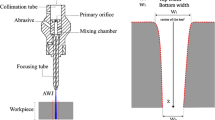Abstract
Cutting is one of the most important applications of abrasive water jet. However, there are always some quality defects in the cross section cut by abrasive water jet. It is found that multipass abrasive water jet cutting can effectively improve the cutting quality. In this paper, two types of multipass water jet cutting were summarized and redefined clearly first. Then, taking AISI 304 stainless steel as the workpiece, the cross sections after cutting with different cutting times were analyzed and compared with that after single cutting. The overall roughness and the overall taper of the section were obtained by a reasonable method. Besides, in order to give consideration to both the cutting quality and the processing time, the concept of quality improvement rate was put forward. On this basis, with the improvement rate as the index, the optimal cutting times for cutting AISI 304 stainless steel with multipass abrasive water jet were analyzed from two aspects of surface quality and kerf taper, and the optimal cutting times of cutting other materials by multipass abrasive water jet can be studied according to the same idea. The study of this paper provides important reference for the application of multipass abrasive water jet cutting.
Similar content being viewed by others
Change history
02 January 2020
Author Meiping Wu wmp169@jiangnan.edu.cn should also be declared as the corresponding author of the article https://doi.org/10.1007/s00170-018-2011-0.
References
Liang GF (1997) Cutting technical manual, Beijing: China Machine Press
Begic-Hajdarevica D, Cekica A, Mehmedovic M (2015) Experimental study on surface roughness in abrasive water jet cutting. Procedia Eng 100:394–399
Kim J, Song J (2015) Abrasive water jet cutting methods for reducing blast-induced ground vibration in tunnel excavation. Int J Rock Mech Min 75:147–158
Bouda F, Carpenter C, Folkes J (2010) Abrasive waterjet cutting of a titanium alloy: the influence of abrasive morphology and mechanical properties on workpiece grit embedment and cut quality. J Mater Process Tech 210:2197–2205
Haghbin N, Spelt JK, Papini M (2015) Abrasive waterjet micro-machining of channels in metals: model to predict high aspect-ratio channel profiles for submerged and unsubmerged machining. J Mater Process Tech 222:399–409
Gupta TVK, Ramkumar J, Tandon P (2015) Application of artificial neural networks in abrasive water jet milling. Procedia CIRP 37:225–229
Valíček J, Hloch S, Kozak D (2009) Surface geometric parameters proposal for the advanced control of abrasive waterjet technology. Int J Adv Manuf Technol 41:323–328
Hloch S, Valíček J, Simkulet V (2009) Estimation of smooth zone maximal depth at surfaces created by abrasive waterjet. Int J Surf Sci Eng 3:347–359
Chen FL, Siores E (2003) The effect of cutting jet variation on surface striation formation in abrasive water jet cutting. J Mater Process Tech 135:1–5
Çaydas U, Hasçalõk A (2008) A study on surface roughness in abrasive waterjet machining process using artificial neural networks and regression analysis method. J Mater Process Tech 202:574–582
Hloch S, Valíček J (2012) Topographical anomaly on surfaces created by abrasive waterjet. Int J Adv Manuf Technol 59:593–604
Zhao W, Guo CW (2014) Topography and microstructure of the cutting surface machined with abrasive waterjet. Int J Adv Manuf Technol 73:941–947
Chen L, Siores E, Wong WCK (1998) Optimising abrasive waterjet cutting of ceramic materials. J Mater Process Tech 74(1–3):251–254
Lemma E, Chen L, Siorcs E, Wang J (2002) Optimising the AWJ cutting process of ductile materials using nozzle oscillation technique. Int J Mach Tool Manu 42(7):781–789
Zeng J, Olsen J, Olsen C, Guglielmetti B (2005) Taper free abrasive waterjet cutting with a tilting head. In: 2005 WJTA American waterjet conference. Houston, pp 7A-2
Hlaváč LM (2009) Investigation of the abrasive water jet trajectory curvature inside the kerf. J Mater Process Tech 209(8):4154–4161
Matsui S, Matsumura H, Ikemoto Y, Tsujita K, Shimizu H (1990) High precision cutting method for metallic materials by abrasive waterjet. In: Proceedings of the 10th international symposium on jet cutting technology. Amsterdam, pp 263–278
Hashish M (2004) Precision cutting of thick materials with AWJ. In: BHR group 2004 water jetting 33–46
Wang S, Zhang S, Wu Y, Yang F (2017) Exploring kerf cut by abrasive waterjet. Int J Adv Manuf Technol 93:2013–2020
Xu S, Wang J (2006) A study of abrasive waterjet cutting of alumina ceramics with controlled nozzle oscillation. Int J Adv Manuf Technol 27(7–8):693–702
Hashish M, Plessis MPD (1979) Prediction equations relating high velocity jet cutting performance to stand off distance and multipasses. J Manufa Sci Eng 101(3):311–318
Wang J, Guo DM (2003) The cutting performance in multipass abrasive waterjet machining of industrial ceramics. J Mater Process Tech 133(3):371–377
Dittrich M, Dix M, Kuhl M, Palumbo B, Tagliaferri F (2014) Process analysis of water abrasive fine jet structuring of ceramic surfaces via design of experiment. Procedia CIRP 14:442–447
Alberdi A, Artaza T, Suárez A (2017) An experimental study on abrasive waterjet cutting of CFRP/Ti6Al4V stacks for drilling operations. Int J Adv Manuf Technol 86(1–4):691–704
Funding
This work is supported by, The National Natural Science Foundation of China (51575237), The joint fund of Ministry of education of China (6141A0221) and Postgraduate Research & Practice Innovation Program of Jiangsu Province.
Author information
Authors and Affiliations
Corresponding author
Rights and permissions
About this article
Cite this article
Miao, X., Qiang, Z., Wu, M. et al. The optimal cutting times of multipass abrasive water jet cutting. Int J Adv Manuf Technol 97, 1779–1786 (2018). https://doi.org/10.1007/s00170-018-2011-0
Received:
Accepted:
Published:
Issue Date:
DOI: https://doi.org/10.1007/s00170-018-2011-0




